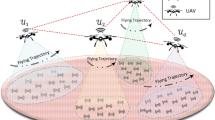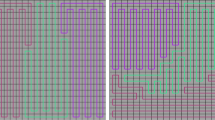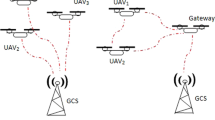Abstract
This paper proposes a novel mission planning platform, capable of efficiently deploying a team of UAVs to cover complex-shaped areas, in various remote sensing applications. Under the hood lies a novel optimization scheme for grid-based methods, utilizing Simulated Annealing algorithm, that significantly increases the achieved percentage of coverage and improves the qualitative features of the generated paths. Extensive simulated evaluation in comparison with a state-of-the-art alternative methodology, for coverage path planning (CPP) operations, establishes the performance gains in terms of achieved coverage and overall duration of the generated missions. On top of that, DARP algorithm is employed to allocate sub-tasks to each member of the swarm, taking into account each UAV’s sensing and operational capabilities, their initial positions and any no-fly-zones possibly defined inside the operational area. This feature is of paramount importance in real-life applications, as it has the potential to achieve tremendous performance improvements in terms of time demanded to complete a mission, while at the same time it unlocks a wide new range of applications, that was previously not feasible due to the limited battery life of UAVs. In order to investigate the actual efficiency gains that are introduced by the multi-UAV utilization, a simulated study is performed as well. All of these capabilities are packed inside an end-to-end platform that eases the utilization of UAVs’ swarms in remote sensing applications. Its versatility is demonstrated via two different real-life applications: (i) a photogrametry for precision agriculture and (ii) an indicative search and rescue for first responders missions, that were performed utilizing a swarm of commercial UAVs. An implementation of the the mCPP methodology introduced in this work, as well as a link for a demonstrative video and a link for a fully functional, on-line hosted instance of the presented platform can be found here: https://github.com/savvas-ap/mCPP-optimized-DARP.























Similar content being viewed by others
Notes
This HFOV was selected as a typical specification for commercial UAVs, based on the sensor that one of the most popular commercial UAVs is equiped with (DJI phantom 4 pro: https://www.dji.com/phantom-4-pro/info#specs)
GSD is calculated from the take off position, considering that the whole ROI has an almost flat topology. In order to have a constant GSD for ROIs with altitude variations, the flight altitude should be adjusted based on the actual distance from the ground, at each point of the region (see alsoGómez-López et al. (2020)).
Dell XPS 9570
Xiaomi Mi Max 2
tp-link M7350
References
Agmon, N., Hazon, N., & Kaminka, G. A. (2006) Constructing spanning trees for efficient multi-robot coverage. In Proceedings 2006 IEEE international conference on robotics and automation, 2006. ICRA 2006, pp. 1698–1703. IEEE .
Al-Kaff, A., Moreno, F. M., José, L. J. S., García, F, Martín, D, Escalera, A. de la, Nieva, A., & Garcéa, José L. M. (2017). Vbii-uav: Vision-based infrastructure inspection-uav. In World conference on information systems and technologies, pp. 221–231. Springer,.
Bähnemann, R., Lawrance, N., Chung, J. J., Pantic, M., Siegwart, R., & Nieto, J. (2019) Revisiting boustrophedon coverage path planning as a generalized traveling salesman problem. arXiv preprintarXiv:1907.09224,
Barrientos, A., Colorado, J., del Cerro, J., Martinez, A., Rossi, C., Sanz, D., & Valente, J. (2011). Aerial remote sensing in agriculture: A practical approach to area coverage and path planning for fleets of mini aerial robots. Journal of Field Robotics, 28(5), 667–689.
Bejiga, M. B., Zeggada, A., Nouffidj, A., & Melgani, F. (2017). A convolutional neural network approach for assisting avalanche search and rescue operations with uav imagery. Remote Sensing, 9(2), 100.
Blum, A., Dan, C., & Seddighin, S. (2021). Learning complexity of simulated annealing. In International conference on artificial intelligence and statistics, pp. 1540–1548. PMLR.
Bochkarev, S., & Smith, S. L. (2016). On minimizing turns in robot coverage path planning. In 2016 IEEE international conference on automation science and engineering (CASE), pp. 1237–1242. IEEE .
Cabreira, T., Brisolara, L. F., Jr., & Paulo, R. (2019). Survey on coverage path planning with unmanned aerial vehicles. Drones, 3(1), 4.
Cai, G., Chen, B. M., & Lee, T. H. (2011). Coordinate systems and transformations. In Unmanned rotorcraft systems, pp. 23–34. Springer.
Choset, H., & Pignon, P. (1998). Coverage path planning: The boustrophedon cellular decomposition. In Field and service robotics, pp. 203–209. Springer.
Choset, H. (2001). Coverage for robotics: A survey of recent results. Annals of Mathematics and Artificial Intelligence, 31(1–4), 113–126.
Comba, L., Biglia, A., Aimonino, D. R., & Gay, P. (2018). Unsupervised detection of vineyards by 3d point-cloud uav photogrammetry for precision agriculture. Computers and Electronics in Agriculture, 155, 84–95.
Coombes, M., Chen, W.-H., & Liu, C. (2017). Boustrophedon coverage path planning for uav aerial surveys in wind. In 2017 International conference on unmanned aircraft systems (ICUAS), pp. 1563–1571. IEEE.
Deng, L., Mao, Z., Li, X., Zhuowei, H., Duan, F., & Yan, Y. (2018). Uav-based multispectral remote sensing for precision agriculture: A comparison between different cameras. ISPRS Journal of Photogrammetry and Remote Sensing, 146, 124–136.
Di Franco, C., & Buttazzo, G. (2016). Coverage path planning for uavs photogrammetry with energy and resolution constraints. Journal of Intelligent& Robotic Systems, 83(3–4), 445–462.
Gabriely, Y., & Rimon, E. (2001). Spanning-tree based coverage of continuous areas by a mobile robot. Annals of Mathematics and Artificial Intelligence, 31(1–4), 77–98.
Galceran, E., & Carreras, M. (2013). A survey on coverage path planning for robotics. Robotics and Autonomous Systems, 61(12), 1258–1276.
Ghaemi, S., Rahimi, P., & Nobes, D. S. (2009). Evaluation of digital image discretization error in droplet shape measurement using simulation. Particle& Particle Systems Characterization, 26(5–6), 243–255.
Gómez-López, J. M., Pérez-García, J. L., Mozas-Calvache, A. T., & Delgado-García, J. (2020). Mission flight planning of rpas for photogrammetric studies in complex scenes. ISPRS International Journal of Geo-Information, 9(6), 392.
Gower, J. C., & Ross, G. J. S. (1969). Minimum spanning trees and single linkage cluster analysis. Applied Statistics, 18(1), 54.
Guruprasad, K. R. (2019). X-stc: An extended spanning tree-based coverage algorithm for mobile robots. In Proceedings of the Advances in Robotics, 2019, 1–6.
Ham, Y., Han, K. K., Lin, J. J., & Golparvar-Fard, M. (2016). Visual monitoring of civil infrastructure systems via camera-equipped unmanned aerial vehicles (uavs): A review of related works. Visualization in Engineering, 4(1), 1.
Hazon, N, & Kaminka, G. A. (2005). Redundancy, efficiency and robustness in multi-robot coverage. In Proceedings of the 2005 IEEE international conference on robotics and automation, pp. 735–741. IEEE .
Huang, X., Sun, M., Zhou, H., & Liu, S. (2020). A multi-robot coverage path planning algorithm for the environment with multiple land cover types. IEEE Access .
Hunt, E. R., Jr., & Daughtry, C. S. T. (2018). What good are unmanned aircraft systems for agricultural remote sensing and precision agriculture? International Journal of Remote Sensing, 39(15–16), 5345–5376.
Ivan, M., & Ollero, A. (2007). Multiple uav cooperative searching operation using polygon area decomposition and efficient coverage algorithms. Distributed Autonomous Robotic Systems, 6, 221–230.
Kapoutsis, A. C., Chatzichristofis, S. A., Doitsidis, L., Sousa, J. B. de, Pinto, J., Braga, J., & Kosmatopoulos, E. B. (2015). Real-time adaptive multi-robot exploration with application to underwater map construction. Autonomous Robots, pp. 1–29 .
Kapoutsis, A. C., Chatzichristofis, S. A., & Kosmatopoulos, E. B. (2017). Darp: Divide areas algorithm for optimal multi-robot coverage path planning. Journal of Intelligent& Robotic Systems, 86(3–4), 663–680.
Kapoutsis, A. C., Chatzichristofis, S. A., & Kosmatopoulos, E. B. (2019). A distributed, plug-n-play algorithm for multi-robot applications with a priori non-computable objective functions. The International Journal of Robotics Research, 38(7), 813–832.
Karatzinis, G. D., Apostolidis, S. D., Kapoutsis, A. C., Panagiotopoulou, L., Boutalis, Y. S., & Kosmatopoulos, E. B. (2020). Towards an integrated low-cost agricultural monitoring system with unmanned aircraft system. In 2020 International conference on unmanned aircraft systems (ICUAS), pp. 1131–1138. IEEE.
Kirkpatrick, S., Gelatt, C. D., & Vecchi, M. P. (1983). Optimization by simulated annealing. Science, 220(4598), 671–80.
Koutras, D., Kapoutsis, A., & Kosmatopoulos, E. (2020). Autonomous and cooperative design of the monitor positions for a team of uavs to maximize the quantity and quality of detected objects. IEEE Robotics and Automation Letters, 5(3), 4986–4993.
Lewis, J. S., Edwards, W., Benson, K., Rekleitis, I., & O’Kane, J. M. (2017). Semi-boustrophedon coverage with a dubins vehicle. In 2017 IEEE/RSJ international conference on intelligent robots and systems (IROS), pp. 5630–5637. IEEE.
Li, Y., Chen, H., Er, M. J., & Wang, X. (2011). Coverage path planning for uavs based on enhanced exact cellular decomposition method. Mechatronics, 21(5), 876–885.
Maes, W. H., & Steppe, K. (2019). Perspectives for remote sensing with unmanned aerial vehicles in precision agriculture. Trends in plant science, 24(2), 152–164.
Paradzik, M., & İnce, G. (2016). Multi-agent search strategy based on digital pheromones for uavs. In 2016 24th signal processing and communication application conference (SIU), pp. 233–236. IEEE .
Qi, J., Song, D., Shang, H., Wang, N., Hua, C., Wu, C., et al. (2016). Search and rescue rotary-wing uav and its application to the lushan ms 7.0 earthquake. Journal of Field Robotics, 33(3), 290–321.
Redmon, J., & Farhadi, A. (2018). Yolov3: An incremental improvement. arXiv preprint arXiv:1804.02767
Rekleitis, I., New, A. P., Rankin, E. S., & Choset, H. (2008). Efficient boustrophedon multi-robot coverage: an algorithmic approach. Annals of Mathematics and Artificial Intelligence, 52(2), 109–142.
Renzaglia, A., Dibangoye, J., Doze, V. L., & Simonin, A. O. (2020). common optimization framework for multi-robot exploration and coverage in 3d environments. Journal of Intelligent & Robotic Systems, pp. 1–16,
Rudol, P., & Doherty, P. (2008). Human body detection and geolocalization for uav search and rescue missions using color and thermal imagery. In 2008 IEEE aerospace conference, pp. 1–8. IEEE .
Shah, K., Ballard, G., Schmidt, A, & Schwager, M. (2020). Multidrone aerial surveys of penguin colonies in antarctica. Science Robotics, 5(47) .
Stolfi, D. H., Brust, M. R., Danoy, G., Bouvry, P. (2020) A cooperative coevolutionary approach to maximise surveillance coverage of uav swarms. In 2020 IEEE 17th annual consumer communications & networking conference (CCNC), pp. 1–6. IEEE,
Sun, J., Li, B., Jiang, Y., & Wen, C. (2016). A camera-based target detection and positioning uav system for search and rescue (sar) purposes. Sensors, 16(11), 1778.
Zheng, X., Jain, S., Koenig, S., & Kempe, D. (2005). Multi-robot forest coverage. In 2005 IEEE/RSJ international conference on intelligent robots and systems, pp. 3852–3857. IEEE
Acknowledgements
This project has received funding from the European Commission under the European Union’s Horizon 2020 research and innovation programme under grant agreement no 833805 (ARESIBO).
Author information
Authors and Affiliations
Corresponding author
Additional information
Publisher's Note
Springer Nature remains neutral with regard to jurisdictional claims in published maps and institutional affiliations.
Rights and permissions
About this article
Cite this article
Apostolidis, S.D., Kapoutsis, P.C., Kapoutsis, A.C. et al. Cooperative multi-UAV coverage mission planning platform for remote sensing applications. Auton Robot 46, 373–400 (2022). https://doi.org/10.1007/s10514-021-10028-3
Received:
Accepted:
Published:
Issue Date:
DOI: https://doi.org/10.1007/s10514-021-10028-3




